Overview
The fern group of plants encompasses several genera and thousands of flowerless species with delicate fronds and bright-green foliage. Ferns often grow in forests and woodlands. They perform well in containers indoors or outdoors
Ferns’ structure differs from the structure of many other plants. Fern leaves, which are called fronds, have two parts: a single stalk, called a stipe, and blades, the broad part of the frond. The fronds attach to rhizomes, which are equivalent to stems of other plants and contain the bundles of tissue that carry water and nutrients to other parts of the plants. The rhizomes can be either above or below ground, depending on the fern variety, and from them come the roots. Instead of flowers or seeds, ferns have sporangia, little capsules or sacks in which spores are produced. They are usually on the underside of the fronds.
With their graceful, usually stemless fronds, ferns can brighten shaded areas in the garden, adding motion and color to dark places underneath trees and shrubs, or giving woodland gardens a cool, tropical atmosphere. Ferns require well-drained soil. Most prefer soil rich in organic matter but can often grow in poor and rocky soils with little trouble. Although most ferns need moist soils to thrive, several species are drought-tolerant and require little to no supplemental watering during dry spells.
Types/Varieties Of Fern Plants
1. Boston Fern
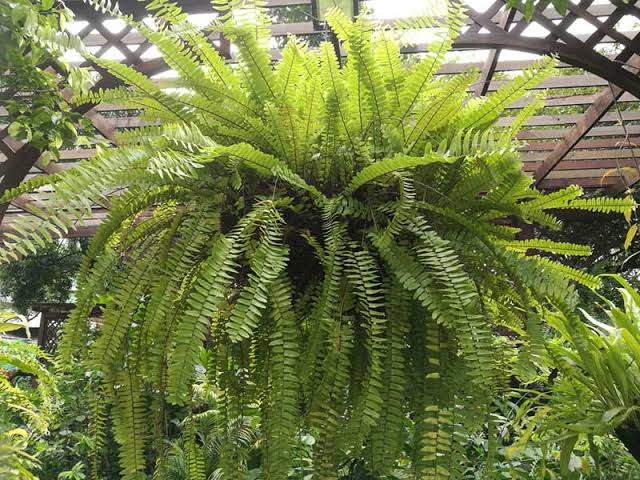
The Boston fern (Nephrolepsis exaltata) also referred to as sword fern, reaches a mature height of 3 to 4 feet tall, forming long fronds from a central clump. Commonly grown as a houseplant, Boston fern, despite its name, actually hails from warm, tropical areas such as Florida, South and Central America, Africa, Polynesia and the West Indies.
Like many other varieties of semitropical plants, Boston fern grows as a perennial in warm climates, but won’t overwinter in areas that experience freezing temperatures. In cold climates, you must bring this type of fern indoors or grow it as an annual. The long, pale green and arching fronds of the Boston fern make it an excellent plant for containers and hanging baskets.
2. Western Sword Fern

Western sword fern (Polystichum munitum) comes from the Western U.S. and generally grows in U.S. Department of Agriculture plant hardiness zones 3 through 8. This 2- to 4-foot-tall evergreen plant grows in poor, dry soil and tolerates hot weather. A single mature fern can have 75 to 100 dark green, leathery fronds. This perennial actively grows in spring, summer and fall, going dormant in winter. The Western sword fern is highly resistant to plant diseases and garden pests. It is considered an easy-care ground cover for shady areas.
Also Read: Different Types of Palm Trees
3. Asparagus Fern

Asparagus ferns (Asparagus densiflorus) produce feathery fronds, which grow upright to about 24 inches. Some varieties arch over when they grow taller. This evergreen plant has thorns that can grow large enough to pierce the skin. The asparagus fern is not related to the fern family since it produces tiny white flowers and bright red berries. These ferns are closely related to the asparagus and commonly used as an ornamental plant.
The asparagus fern isn’t exactly a common houseplant, but with its feathery, light foliage, it’s quite attractive and can be successfully grown indoors. Asparagus ferns are low-maintenance tuberous plants that have some requirements that must be met for them to grow healthy.
In warm, humid climates, asparagus ferns can spread rapidly when planted outdoors. It is considered an invasive species in Florida, Texas, and Hawaii. Asparagus fern is also toxic to children and pets.
4. Holly Fern

Holly fern, named for the pointy tips on its leathery leaves, is a drought-resistant plant native to Africa and Asia. This fern thrives in low light, so it’s ideal for shady areas under trees. Holly fern forms loose two to three-foot tall clumps of deep green leathery leaves. They can be used in partially sunny to fully shady spots as a border plant, ground cover, or in a woodland garden. They can also be kept in pots on covered patios. It makes an excellent understory plant beneath old reclaimed plants like camellia, sweet olive, and other large shrubs which have had their lower branches removed.
Holly fern’s dark green color makes for a great background when grouped with more colorful plants. Holly fern will stay green year-round in climates where it’s protected from frost; however, colder temperatures will cause the fern to lose its fronds. The fronds can also be used in cut flower arrangements.
5. Kangaroo Fern

Kangaroo foot fern, also known as kangaroo paw fern (Microsorum diversifolium), is native to Australia and commonly grown for ornamental purposes in pots or in the ground. It is a cool-climate fern distinguished by its firm fronds, which grow to various lengths. Kangaroo paw fern produces shiny green leaves and reaches just below 1 foot tall and up to 2 to4 feet wide when fully grown.
Kangaroo fern is among the few fern species that prefer drier air to humid air. It is sometimes grown as ground cover. Because of its unusual growth habit and oddly shaped leaves, this shade and moisture-loving plant has deservedly earned the moniker of kangaroo paw fern.
6. Himalayan Maidenhair Ferns

Maidenhair fern (Adiantum spp.) is a large genus of tropical ferns with bright green, fan-shaped leaves. The plant is valued not only for its beauty, but for its ability to grow in full or partial shade. Maidenhair ferns have delicate fan-shaped leaf segments, typically clustered on wiry black stems.
In addition to being a popular houseplant, maidenhair fern can also be found in nature, growing in places where other plants typically don’t, like on rock walls and in between rock fissures where the moisture from water seepage keeps them alive. Though they are visually stunning throughout all stages of their growth, they are considered a slow-growing fern, typically taking up to three years to reach their full mature size.
Also Read: Varieties of Jasmine Shrub
7. Staghorn Ferns

Staghorn ferns, sometimes called elkhorn ferns, are epiphytic species of the genus Platycerium. Epiphytic means they grow on other plants or trees. The green part of the antler-shaped fronds from which they get their name conducts photosynthesis, while the brown base obtains nutrients from fallen debris and insects. They grow as indoor houseplants in all climates. The ferns grow well in moss and bark-filled hanging baskets or large pots but need ample space to spread their large, rounded and antler-forked fronds, which may grow 3 feet high and 3 feet wide.
8. Ostrich Ferns
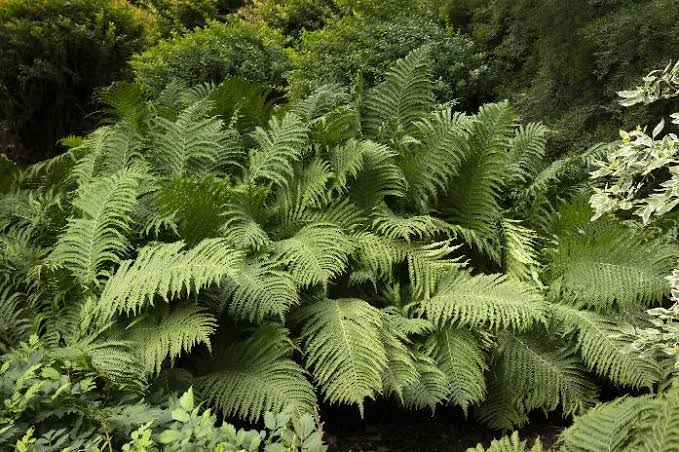
Ostrich ferns (Matteuccia struthiopteris) are especially showy. These deciduous ferns produce large, upright clumps of finely dissected medium green fronds, which resemble long feathery ostrich plumes. Emerging from the base in spring, these vegetative fronds grow in a way that is similar to the familiar curly fiddlehead ferns as they unfurl. Each frond can grow to be up to four feet long.
The entire upright, arching, rhizomatous plant spreads five to eight feet wide and grows two to three feet tall, and even up to six feet tall in moist, cool climates in the wild.
The sterile fronds create a massive crown, shaped like a vase, around the less showy, spiky, erect, dark brown fronds. As summer continues, the fertile fronds usually wilt and become tattered by early fall as they lose their leaflets entirely (earlier than most ferns) and go dormant by winter.
9. Japanese Painted Ferns

The Japanese painted fern (Athyrium niponicum) “Red Beauty” bears arching, triangular, fronds with intense burgundy-red veins and stems. It’s exceptional in mixed containers and grows 16 to 29 inches tall by 12 to 18 inches wide in hardiness zones 4 through 9.
10. Australia Tree Fern

Australian tree fern (Sphaeropteris cooperi or Cyathea cooperi) is a tropical fern that can reach a height of 15 or even 30 feet. It is also known as Cooper’s tree fern and lacy tree fern due to its lacy fronds. The long, large leaves form a handsome canopy and give a tropical feel to the landscape.
The trunk of the Australian tree fern starts out as a low, wide clump and spreads as much as six feet in a year before growing upward into a single slender trunk covered in glossy, ginger-brown hairs. The fronds are broad, bright green with triangular lacy leaves; they do not change color in the fall, and there are no flowers or fruit. The fast-growing Australian tree fern can bring an exotic touch to any garden. It’s best planted in the early spring and prefers warm temperatures and plentiful sunlight year-round.
11. Bird Nest Ferns

Bird’s nest ferns (Asplenium nidus) are naturally epiphytic, meaning they grow on the surface of other plants. In their rainforest homes, they can be found growing high in the crooks of trees. They form a series of erect, spoon-shaped, bright green fronds that rise from a central rosette. Healthy plants can have fronds up to 5 feet long, but bird’s nest ferns grown as houseplants typically have fronds that grow only about 2 feet long. The plants have a moderate growth rate. They’re best planted in the spring, though houseplants generally can be started year-round.
12. Cinnamon Ferns (Fiddlehead fern)

Cinnamon fern also referred to as fiddlehead fern (Osmunda cinnamomea) is a handsome, deciduous fern with showy, blue-green fronds. New growth is white and fuzzy, which provides contrast to the mature, cinnamon-colored fronds. The plant grows in large clumps measuring as much 6 feet tall with a 1-foot spread.
The fronds of cinnamon fern occur in groups, rising from a shallow, black rootstock. Fertile fronds appear first as silvery, furry fiddleheads, ultimately becoming stiff, erect, and covered with specialized pinnae, which turn their upper portions into a thick spike of fruit dots – turning from green to chocolate brown. Sterile fronds bend outwards forming a vase-shaped circle enclosing the “cinnamon” fronds.
Also Read: Varieties of Black-eyed Susan
13. Royal Fern
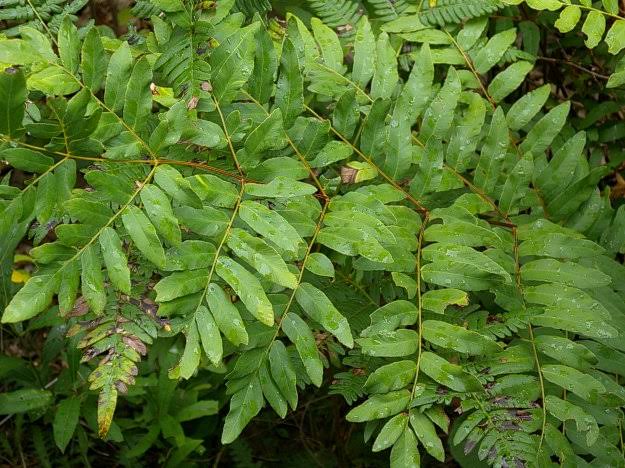
The royal fern (Osmunda regalis) is extremely large, growing up to 6 feet tall and over 2 feet in width. It’s an excellent fern to plant if your property has extremely moist conditions. The base of the fern changes with maturity, alternating between greens, tans and browns. Unlike the other ferns, the fronds and leaves are widely spaced.
14. Blue Star Fern
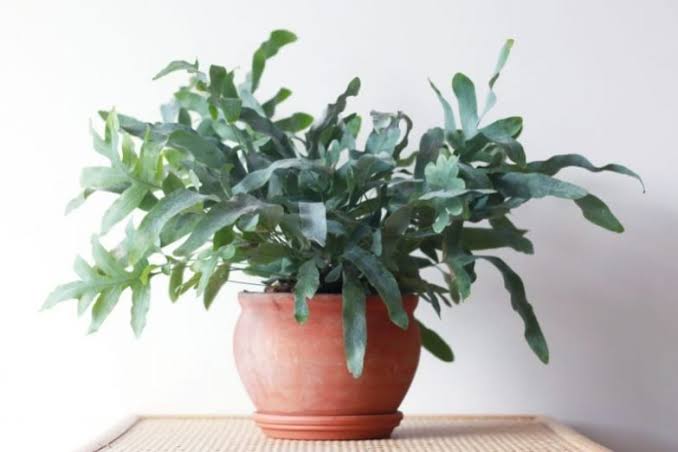
The blue star fern (Phlebodium aureum) is epiphytic fern commonly known as ‘Golden Polypody’. This popular houseplant, member of oak family, has curly bluish green leaves that do not shed upon getting old. They prefer to branch into fingers and retain plant’s attractiveness and symbolize star fern.
Phlebodium aureum is mostly found in tropical forests in South-America, although its natural range also extends into North America. Here it doesn’t grow in the soil like most other plants. Instead, it features a creeping rhizome that allows it to grows on trees in a non-parasitic way. This allows it to reach higher than many plants that grow on the ground, right into the canopies.
15. Cretan Brake Fern

Pteris cretica, the Cretan brake, ribbon fern, or Cretan brake fern, is a species of evergreen fern in the family Pteridaceae, native to Europe, Asia and Africa. Cretan Brake Fern, displays colorful grey-green fronds with bold white center stripes. It also exhibits an upright, clumping habit. Cretane brake grows in pastures, deciduous and coniferous woodlands, and hillsides. It prefers acidic soils.
16. Eagle Fern
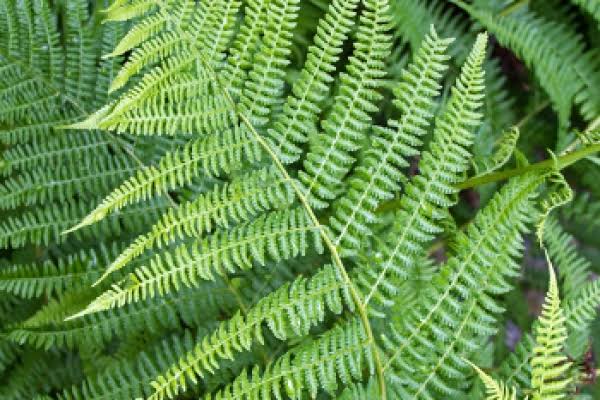
Pteridium aquilinum (bracken, brake or common bracken), also known as eagle fern, is a species of fern occurring in temperate and subtropical regions in both hemispheres. Large, roughly triangular fronds are produced singly, arising upwards from an underground rhizome, and grow to 1–3 m tall; the main stem, or stipe, is up to 1 cm diameter at the base.
17. Crocodile Fern
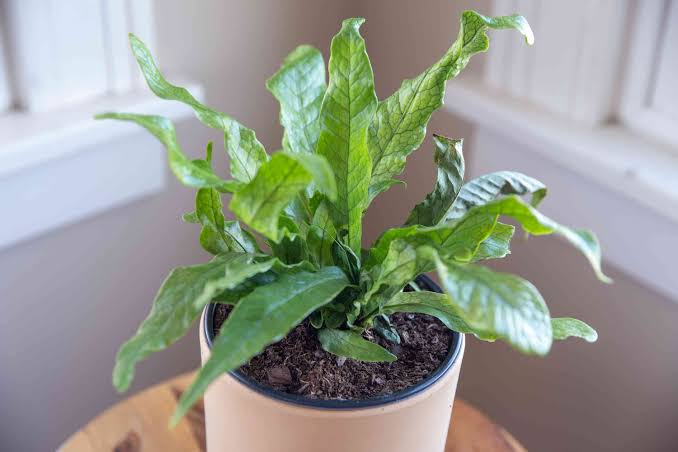
Crocodile ferns (Microsorum musifolium) have lots of personality. Getting their name from their reptilian texture, these ferns resemble crocodile skin. They have long, broad leaves with dark green veins and a leathery appearance. Typically found in Southeast Asia and parts of Australia, this fern thrives in humid, tropical environments. They make great statement pieces since they can grow up to five feet.
18. Giant Wood Fern
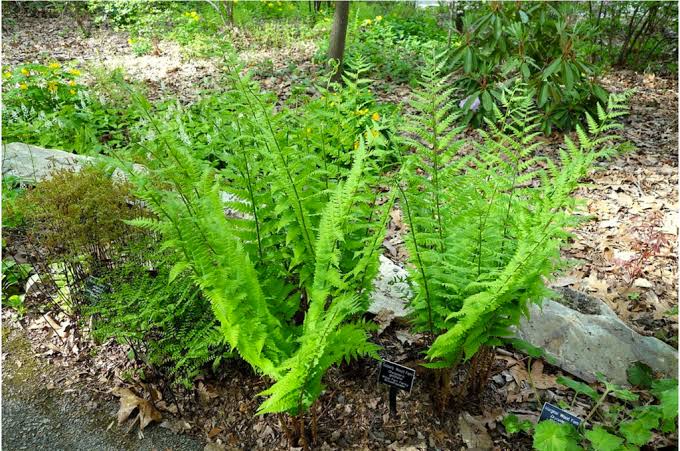
Dryopteris goldieana, commonly called Goldie’s wood fern, or giant wood fern is a fern native to the eastern United States. Goldie’s fern is common in moist rich woods, ravines, seeps, or at the edges of swamps and in areas with full or partial shade. It grows in a clumped form where all the leave emerge from the same point on the ground.
The leaf of this plant is thick in texture but not evergreen. It may range from dark green to golden green color. The leaves may be 35–120 cm in length and 15–40 cm in width depending on the specimen. The base of the leaf is not strongly tapering and the bottom leaflets are only slightly smaller than the leaflets directly above them.
Also Read: Varieties of Anthurium Plants
19. Rabbit’s Foot Fern

The rabbit’s foot fern (Davallia fejeensis) earned its common name from its fuzzy, creeping rhizomes, which resemble delicate rabbit feet spreading around the base of the plant. The rabbit’s foot fern is epiphytic, which means it gets much of its nutrients from humid air and sometimes plant debris that collects around the fern.
The plant is native to Fiji, and in its native habitat, it attaches itself to tree limbs or rocks for stabilization. A rabbit’s foot fern can grow to a maximum height of 3 feet and width of 4 feet. This means the plant might quickly outgrow a single lava rock, unless that rock is very large.
20. Hard Fern
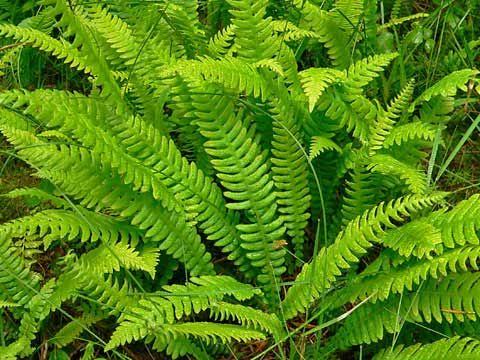
Hard fern, Blechnum spicant, has tough leathery, glossy fronds. These are ladder-shaped, and older fronds form a loose rosette around the more upright central ones. It provides year-round interest for a shady spot and works well with other shade-loving, woodland plants. It can also be used in dry stone walls and rock gardens.
21. Lemon Button Fern

Lemon buttons fern (Nephrolepis cordifolia) is a kind of Southern sword fern, a wood fern that thrives in shady woodland areas. Growing to only 12 inches tall, lemon buttons fern is named for its demure size and rounded leaflets. It also is called fishbone fern. It is suitable for growing in hardiness zones 8 through 10. Lemon buttons ferns thrive in moist, well-drained, acidic soil with a pH of 4 to 7. This adaptable plant tolerates sea air and salty soil.
22. Christmas Fern

Christmas fern (Polystichum acrostichoides) is a perennial evergreen fern, native to eastern North America, where it is found in moist and shady habitats in woodlands, stream banks and rocky slopes. Christmas fern is a clumping variety that got its name because it stays green through the holidays. Christmas fern reaches 1 1/2 to 2 feet in height and is hardy in zones 3 to 9.
Christmas fern has a tufted, clumping habit, with its fronds arising from a central growth point. It can form colonies, but frequently grows singly or in twos or threes. In winter, the fertile fronds die; the sterile fronds remain through the winter, and are often flattened to the ground by low temperatures and snow cover. The frond is supported by a dark brown- to black-colored stipe, or stem, which is typically a quarter to a third of the overall frond length. Fronds are 30 to 80 cm long and 5 to 12 cm broad, dark green and rather leathery in texture; their undersides may be covered in very sparse hairs.
23. Asian Saber Fern

Polystichum neolobatum, or Asian saber fern, grows in hardiness zones 6 through 9. Also known as the long-eared holly fern, the plant grows to about 2.5 feet tall and produces shiny, leathery, dark-green fronds and a stiffly upright habit. An evergreen, the Asian saber fern’s fronds will turn yellow when the plant receives too much sun. You can Plant this fern in rich, well-drained soil in partial to full shade. Once established, the Asian saber fern rarely needs supplemental watering. Asian saber fern is good for mass plantings and naturalizes easily.
24. Hay-Scented Fern
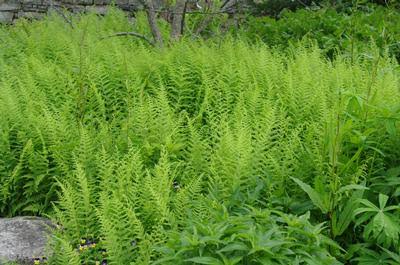
Hay-scented fern (Dennstaedtia punctilobula ) is a rhizomatous fern commonly found in deciduous forests, old fields and roadsides in its native range of the Eastern United States and Canada. It prefers moist, rich soil in partial shade to full sun but can thrive even in poor soils. When touched, this fast-growing fern’s light green fronds release a scent like new-mown hay.
The plant grows 18 to 29 inches tall and spreads up to 16 inches. Take advantage of this fern’s sprawling habit to plant it as a ground cover or grow it as a specimen plant. Hayscented fern naturalizes well in the garden. The fronds turn yellow in autumn. Water hayscented fern regularly until it becomes firmly established and able to withstand drought.
25. Interrupted Fern
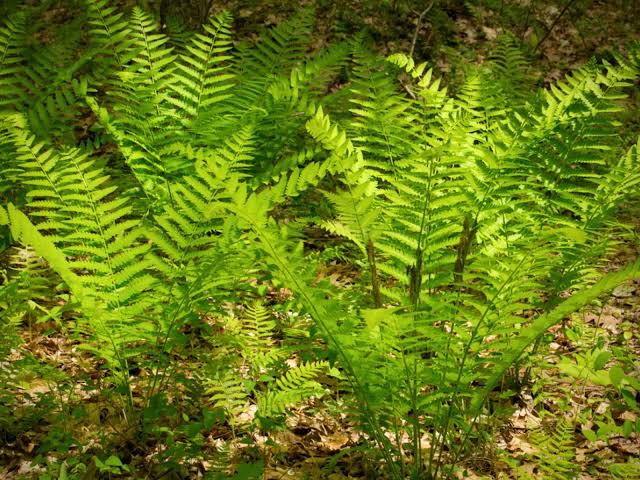
The Interrupted Fern (Osmunda claytoniana) is a large, vase-shaped fern that grows in both wetlands and non-wetlands. The Interrupted Fern gets its name from the distinct interruptions present in the middle section of many of its fronds, caused by the brown or dark green fertile leaflets. Interrupted Ferns usually grow up to three or four feet tall. These are deciduous ferns, which turn golden yellow in the fall before dying back.
Interrupted Ferns are dimorphic which means that the sterile fronds and fertile fronds are different in appearance. The sterile fronds grow in an arching, circular clump emanating from the rhizomes. The Interrupted Fern’s fertile fronds tend to be more upright than the sterile fronds. The fertile fronds usually appear in the center of the fern, surrounded by sterile fronds.
Also Read: Different Types of Sunflower Varieties
26. Sensitive Fern
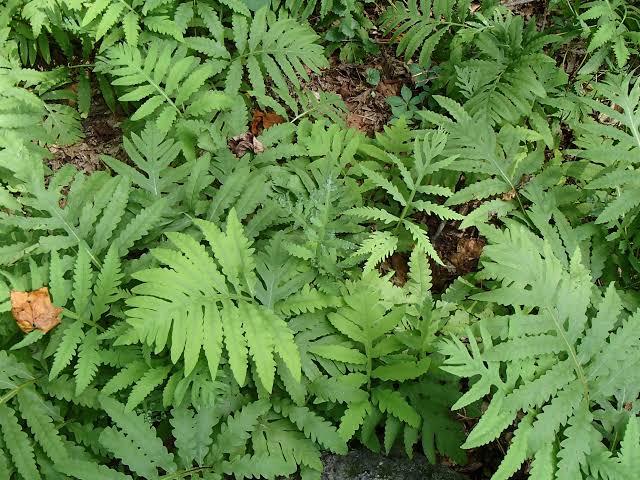
The sensitive fern (Onoclea sensibilis) is so named because it is highly susceptible to frost damage. It grows between 12 and 20 inches tall and up to 11 inches wide. The base is the widest point. Its light green fronds turn to a yellowish red in the fall, echoing deciduous trees. Because it grows quickly, make sure you contain it by either planting it in containers or in a bed with a defined border. Plan for moist soil and, before the plant changes color in the fall, you can harvest the fronds to use in decorative arrangements.
27. Dragon’s Tail Fern

Asplenium × ebenoides (Scott’s spleenwort, dragon tail fern or walking spleenwort) is a small, evergreen, rock-inhabiting fern that grows in discrete clumps. The leaf blades rise from a dark-colored, shiny stem, and show a variable and irregular pattern of cutting. The lower part of the blade may be cut into pinnae or merely to lobes, of varying length, while the upper part of the blade is lobed and comes to a pointed tip, which, on rare occasions, forms a bud that can give rise to new plants. The fronds are weakly dimorphic, the fertile fronds being slightly larger and more upright.
28. Lady Fern

Lady fern (Athyrium filix-femina) is a fast-growing perennial that grows up to 3 feet tall and wide. The fern has feathery green fronds, and does best in moist, shady areas around the house. Lady fern grows in hardiness zones 3 through 9, and can be found growing in forests in the wild as well as in cultivation.
This plant has fronds that are a vibrant green throughout the summer and turn golden-yellow after the first frost. Lady fern stalks can be green, red, or purple. These support a multitude of tiny leaflets, which gives the lady fern its feathery, lacy appearance.
29. Silver Fern
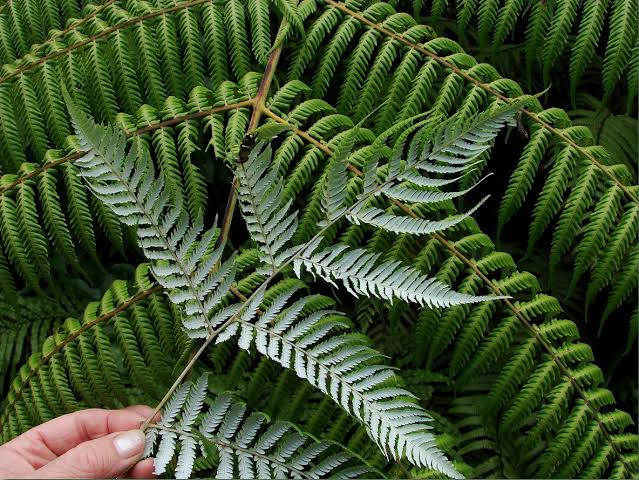
The silver fern (Cyathea dealbata) is a remarkable species of tree fern that displays a narrow brown trunk and elegant green leaves with shimmering silver undersides. The silver fern is endemic to New Zealand, occurring naturally nowhere else in the world. The plant has earned a place of honor as the country’s national emblem and is enjoyed where hardy as a striking garden ornamental.
30. Goldenback Fern
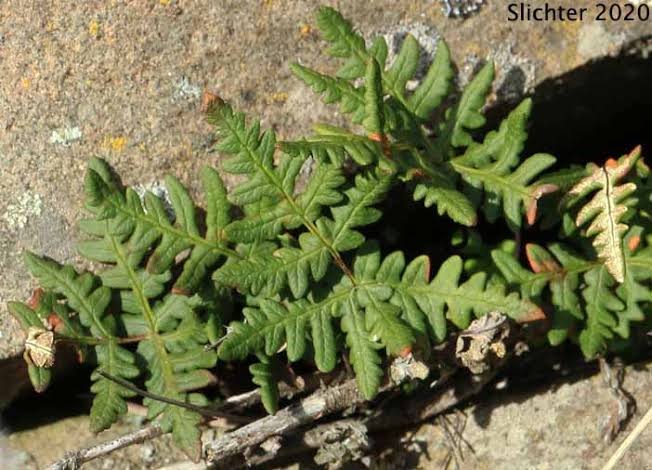
Pentagramma triangularis is a fern, commonly known as goldback fern, native to Western North America, including California. It is commonly found in mixed evergreen and oak forests, occasionally on dry brushy slopes, and prefers shaded areas.
31. Licorice Fern
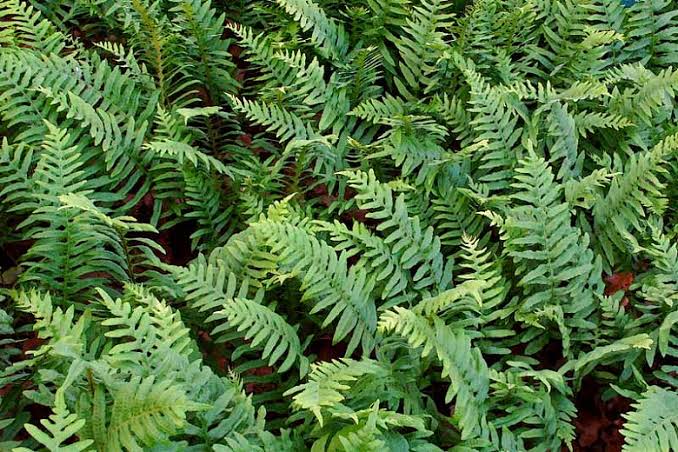
Polypodium glycyrrhiza, commonly known as licorice fern, many-footed fern, and sweet root, is a summer deciduous fern native to western North America, where it is found in shaded, damp locations or foggy areas. In these zones, it is especially common as an epiphyte on the trunks of trees and rock faces. The scaly rhizome of this evergreen fern creeps along the tree trunk or rocks and anchors itself by small roots. It is often hidden by moss.
Licorice fern does not grow its fronds from a centralized location; this is in contrast to other ferns that grow their fronds from the same spot. The rhizome is creeping and the fronds appear to have random placement, originating at various points. The rhizome appears reddish-brown, and has a sweet licorice flavor.
The fronds are triangular and as long as 50 cm, usually smaller. The leaves are only once pinnately divided, each leaflet with pointed tips and finely scalloped or toothed margins, the stipe a naked stalk. The plants remain green and luxuriant during droughts, unlike other polypodys that dry and curl at those times, rehydrating after rains.
The conspicuous round brownish dots distributed on either side of the main vein under each leaflet are the sori (singular sorus). The spores in these reproductive structures are spread by the wind and probably by rain as well. Sporulation occurs from late fall to spring.
Also Read: Various types of Ground Cover Plants
32. Korean Rock Fern
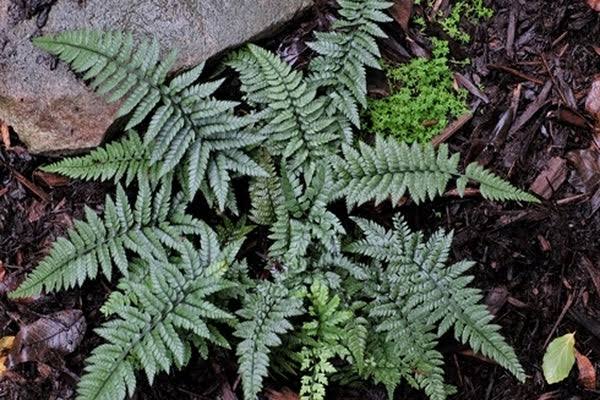
Korean rock fern is a charming little fern perfect for adding texture to shady spots in the garden. Its shiny dark green fronds are a brilliant contrast to lighter colors, such as chartreuse or golden hostas. Korean rock fern makes a wonderful groundcover and will slowly spread through your garden. Or, try Korean rock fern in a container with other shade dwellers. The plant grows 12 to 15 inches tall and is Hardy from zones 7-9.
Korean rock fern grows best in shade and moist, well-drained soil that’s rich in organic matter. Just like many ferns, it prefers an abundance of organic matter in the soil, so be sure to add compost at planting time. Korean rock fern grows best in regions with cool summers.
33. Crow’s Nest Fern

Crow’s nest fern, Asplenium australasicum, is an epiphyte that grows in notches of trees and in depressions in rocks or around the trunks of trees. Long, solid fronds grow in rosettes from a thick base of fine, short roots. Yellow-green to light green fronds grow up to 6 feet long and 7 to 8 inches wide. As crow’s nest ferns grow, outer fronds drop, forming ribs that resemble a trunk, giving an old fern the appearance of a palm tree. Crow’s nest ferns may be misnamed as bird’s nest ferns.
Asplenium nidus, bird’s nest ferns, grow only half as large as crow’s nest ferns; specimens raised as houseplants share cultural requirements with their dramatic cousins but are not hardy enough to grow outdoors, except in summer.
34. Fragile Fern
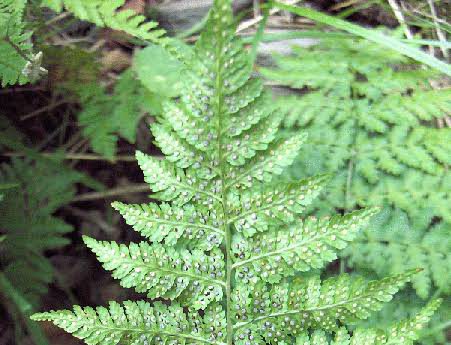
Cystopteris fragilis is a species of fern known by the common names brittle bladder-fern and common fragile fern. It can be found worldwide, generally in shady, moist areas. The leaves are up to 30 or 40 centimeters long and are borne on fleshy petioles. Each leaf is divided into many pairs of leaflets, each of which is subdivided into lobed segments. The underside of the leaf has many rounded sori containing the sporangia.
Also Read: Fast Growing Evergreen Shrubs For Your Yard
35. California Lace Fern
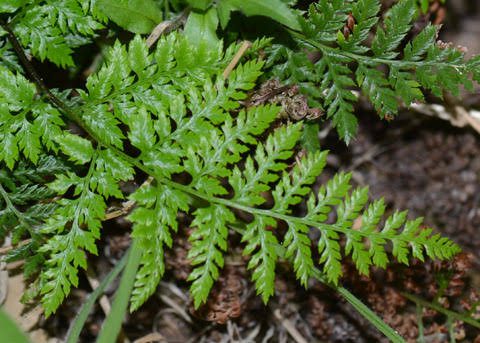
Aspidotis californica is a species of fern known by the common name California lace fern. It is native to California and Baja California. It grows in rock cracks and crevices in many types of habitat, including Chaparral, Yellow pine forest, Foothill oak woodland, and Valley grassland. Aspidotis californica has leaves that are thin and dissected into many triangular leaflets which are subdivided into small segments with curled teeth. The leaf segments bear sori containing sporangia, with the edges of the leaves rolled under to create a false indusium over the sori.
36. Coffee Fern
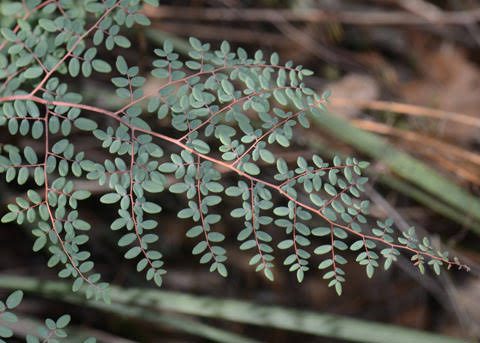
Also known as coffee cliffbrake, coffee fern is a creeping perennial, producing short underground rhizomes and triangular fronds up to two feet long. This plant does not have the immediately recognizable sharply pointed leaflets on its fronds that many other ferns have. Its leaves bear rounded or oval-shaped segments widely spaced along the rachis. Each segment may curl under along its edges. The leaves are green when new, then turn red, purplish, or brown. ). Porangia (spore-producing structures) are partially hidden beneath the in-rolled edges of the pinnae.
37. California Polypody

California polypody (Polypodium californicum) is one of the few ferns found in the Reserve, and the most common one. It is native to moist areas throughout California and northern Baja. California polypody makes its appearance after the first winter rains and disappears during the dry summer months.
California polypody is a perennial, drought-deciduous herb. The leaves (fronds) are produced, often singly, from a rhizome that runs horizontally at or near the surface of the soil. The developing frond emerges from the earth in a tightly coiled position, uncoiling as the frond matures. In California polypody, the mature frond is generally oval or triangular, less than 14 inches (36 cm) long and held above the soil by erect or spreading petioles (stipes) less than half the length of the frond.
38. Shield Fern

Shield fern, also called wood fern or log fern is a medium-sized woodland plant with bright green leathery leaves that are several times divided. They have numerous round spore clusters (sori) attached along the veins on the underside of the leaves and protected by a tissue covering (indusium) that is reniform (kidney-shaped).
39. Giant Chain Fern

Woodwardia fimbriata, known by the common name giant chain fern, has very long fronds, each reaching 1 to 3 meters in length. Named for its sporangia pattern resembling a chain stitch, Woodwardia chain ferns have high-arching fronds with delicate, dark green blades. Their attractive evergreen leaves remain intact until the new spring fronds begin to uncurl. Its sori are short but broad and are arranged in neat lines, the characteristic that gives the chain ferns their name. The chain shape is visible on both sides of each leaflet.
Also Read: Major Types of Arbovitae Plants For Landscaping
40. Mother Shield Fern

Polystichum proliferum also referred to as Mother Shield Fern is a hardy, cool climate terrestrial fern with attractive dark green divided fronds. Its ease of propagation and versatility makes it an ideal horticultural plant which grows well in a wide range of conditions. Polystichum proliferum grows to heights of 130cm high, with a thick rhizome which forms a stout trunk up to 10cm in diameter in older plants.
The rhizome and frond bases are covered in persistent scales which are glossy brown with pale edges. The fronds, which can be 100cm in length, are dark green, leathery and 2-3 divided. The rachis tips have proliferous buds from which young plants, or bulbils, develop. The sori occur in a row on either side of the midrib and are covered by a prominent circular indusium with a dark central spot. It is from the proliferous tips and indusia that the common name, Mother Shield Fern is derived, as it ‘mothers’ offspring and the indusium ‘shields’ the sporangium during development.
Indoor Ferns
With so many species of ferns, it is difficult to determine the exact amount of water any fern needs. Nearly all ferns are native to wooded areas, many from the tropical rain forests, and prefer moist soil. For houseplants, that means watering the plants before the soil in the pot dries. The amount and frequency of watering depends on the size and growth rate of the fern, the potting media it is planted in and the relative humidity and temperature of the home. A large fern may require watering daily, while a small fern in the bathroom – where the humidity is high – may require less frequent watering. The key is to water the fern before the soil dries, but to avoid soggy soil. This means good drainage is vital to the health of indoor ferns.
Outdoor Ferns
Outdoor ferns typically prefer a shaded area where the soil remains moist. As a rule, they prefer 1 to 2 inches of water a week, but this also depends on the soil and the growth rate. Ferns grown in light, sandy soil require more frequent watering than those grown in dense clay soil. Those grown outside in containers may require daily watering because the soil dries quickly in containers, especially during warm spells. Check the soil often and develop a watering routine that keeps the soil moist, but not soggy.
How To Care For Ferns In The Landscape
Ferns require organically rich, well-drained soil. Sandy soil and heavy clay soil benefit from a soil amendment of at least 2 inches of organic matter such as composted bark or leaf mulch to improve soil structure. Most ferns require at least an inch of water every week during spring and summer. However, as a general rule, most ferns grown in sunlight require consistently moist soil.
In their natural wooded environment, most ferns grow amid a natural mulch created by falling pine needles and leaves. Replicate this moist, fertile environment in the garden by surrounding ferns with a 2- to 3-inch layer of chopped bark or pine needles.
Further References
- Facts About Fern Plant: https://en.m.wikipedia.org/wiki/Fern
- Fern Plants Information: https://www.gardeningknowhow.com/ornamental/foliage/tree-ferns/planting-tree-ferns.htm
- Fern Plant: https://animals.sandiegozoo.org/plants/tree-fern
- Types of Fern Plants: https://www.fs.fed.us/wildflowers/beauty/ferns/structure.shtml
- Ferns and Fern Allies of Missouri: https://sites.wustl.edu/monh/ferns-and-fern-allies-of-missouri/